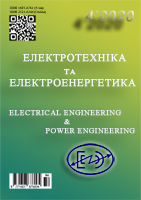Reliability assessment of power supply systems with powerful nonlinear loads
DOI:
https://doi.org/10.15588/1607-6761-2020-4-3Keywords:
the law of distribution of a random variable, ; indicators of reliability of electrical equipment, service life, reliability index, electrical networks, mathematical expectation, inverter equipment, modelingAbstract
Purpose. To substantiate the expediency of applying distribution laws to model the reliability of power supply systems with powerful nonlinear loads.
Methodology. Application of exponential and normal distribution laws, and Weibull's law.
Findings. In a comprehensive assessment of the problem of electromagnetic compatibility and the development of multicriteria parameters of energy efficiency of power supply systems of industrial enterprises, it is most appropriate to use the reliability of the elements that are mathematically described by the Weibull distribution. At the same time, the results of modeling of typical electrical modes and variations of substitution schemes of enterprises showed the sensitivity of reliability indicators to changes in power system capacity.
Originality. New theoretical foundations for research in modern power supply systems with increasing nonlinear load capacity have developed the scientific basis for analysis and synthesis of energy processes in multiphase electrical systems and propose methods of correction taking into account the complex action of sources of electromagnetic interference. And also to offer methods of estimation of their influence on reliability and efficiency of work of the basic electrotechnological equipment.
Practical value. The possibility of applying the obtained results to assess the reliability of power supply systems with powerful nonlinear loads is substantiated. The necessary accuracy and reliability of the decision at the levels of random events, quantities and processes is provided. The mathematical apparatus for the analysis of the main indicators of reliability in the presence of non-sinusoidal voltage is given. Conclusions are made on the adequacy of the calculation results at different stages of electricity distribution. It is shown that the simultaneous optimization of reliability and voltage quality are components of a complex scientific problem of ensuring energy efficiency of electrical networks in the implementation of decentralized models of the energy system.
References
Zharkin A.F., Mostovjak I.V., Palachev S.A. (2006). Puti reshenija problemy vysshih garmonik v jelektricheskih setjah Ukrainy. Tehnіchna elektrodinamіka. Temat. Silova elektronі-ka ta energoefektivnіst'. Vol. 1, 79-82.
Papaika Ju.A., Pіvnjak G.G., Zhezhelenko І.V. (2018). Energetichna efektivnіst' sistem elektropostachannja. Dnipro, NTU «DP», 149.
Zhezhelenko I.V., Saenko Ju.L., A.V. Gorpinich. (2006). Ocenka nadezhnosti oborudovanija pri ponizhen-nom kachestve jelektrojenergii. Vesti v jelektrojenergetike, No 6. 13-17.
Korotkevich M. A. (2015). Ocenka znachenija indeksa na-dezhnosti jenergosistem. Metodicheskie voprosy issledovanija nadezhnosti bol'shih sistem jenergetiki: sbornik nauchnyh statej. Vol. 66, Minsk, BNTU, 54-59.
Nepomnjashhij V.A. (2010). Jekonomicheskie poteri ot na-rushenija jelektrosnabzhenija potrebitelej. Moscow, Izdatel'skij dom MJeI, 188.
Shidlovskij A.K., Pivnjak G.G., Vypanasenko S.I., Slesarev V.V. (2000). Jeffektivnye rezhimy raboty jelektrotehnologicheskih kompleksov. Dnipro. NGA Ukrainy.
Sokolovskaja G.A., Sigareva T.S. (1990). Resursosberezhenie na predpri-jatijah. Moscow. Jekonomika, 156.
Mihajlov V.V. (1973). Nadezhnost' jelektrosnabzhenija promyshlennyh predprijatij. Moscow, Jenergija, 168.
Nepomnjashhij, V.A. (2013). Nadezhnost' oborudovanija jene-rgosistem. Moscow. Jelektrojenergija. Peredacha i raspredelenie, 196.
Papaika, Y., Lysenko, O., Koshelenko, Y.and Oli-shevskyi, I., 2021. Mathematical modeling of power supply reliability at low voltage quality. Naukovyi Visnyk Natsionalnoho Hirnychoho Universytetu, (2), 97-103.
Pivnyak, G., Dychkovskyi, R. (2017). Energy Saving and Efficiency: Technological, Economical and So-cial Challenges. In: Advanced Engineering Forum: monograph. Zurich: Trans Tech Publication Ltd.
Ghosh A., Ledwich G. (2002). Power Quality En-hancement Using Custom Power Devices. Norwell, MA: Kluwer.
Janik P. Photovoltaic Power Generation Assessment Based on Advanced Signal Processing and Optimisation Techniques. Wroclaw: Publishing house of Wroclaw University of Science and Technology Wroclaw, 2014.
Janik P., Kosobudzki G., Schwarz. Influence of increasing numbers of RE-inverters on the power quality in the distribution grids: A PQ case study of a representative wind turbine and photovoltaic system. Higher Education Press and Springer-Verlag Berlin Heidelberg 2017, DOI 10.1007/s11708-017-0469-3.
Olishevskij I. G. (2015). Obosnovanie racional'noj shemy teplonasosnoj sistemy otoplenija. Mehanіka gіroskopіchnih sistem. NTUU «Kiїvs'kij polіtehnіchnij іnstitut». Kiїv, No 30, 26-35.
Ryszard Strzelecki, Henryk Supronowicz. Wspolczynnik mocy w systemach zasilania pradu przemiennego i metody jego poprawy / Ryszard Strzelecki, Henryk Supronowicz, Warszawa: Oficyna Wydaw. Politechniki Warszawskiej, 2000, 452.
Olishevskij I. G., Olishevskij G. S. (2015). Obosno-vanie primenenija tep-lonasosnogo oborudovanija dlja utilizacii teplovyh poter' v silovyh transformato-rah bol'shoj moshhnosti. Vіsnik Dnіpropetrovs'kogo unіversitetu. Serіja: Raketno-kosmіchna tehnіka. Dnіpr. nac. un-t іm. O. Gonchara, Dnіpropetrovs'k, No 4.
Pіvnjak G.G.,. Bіlij M.M. (2005). Elektrifіkacіja gіrnichih robіt. Dnіpropetrovs'k: Nacіonal'nij gіrnichij unіversitet, 320.
Olishevskij G. S., Olishevskij I. G. (2017). Obosno-vanie metoda utiliza-cii teploty sistemy kondicion-irovanija dlja teplonasosnoj sistemy otoplenija. Іn-formacіjnі si-stemi, mehanіka ta keruvannja. NTUU «Kiїvs'kij polіtehnіchnij іnstitut», Kiїv, 2017. No 17. 86-94
Downloads
Published
How to Cite
Issue
Section
License
Copyright (c) 2021 Ю.А. Папаика, А.Г. Лысенко, А.В. Бубликов, И.Г. Олишевский

This work is licensed under a Creative Commons Attribution 4.0 International License.
Creative Commons Licensing Notifications in the Copyright Notices
Authors who publish with this journal agree to the following terms:
Authors retain copyright and grant the journal right of first publication with the work simultaneously licensed under aCreative Commons Attribution License that allows others to share the work with an acknowledgement of the work's authorship and initial publication in this journal.
Authors are able to enter into separate, additional contractual arrangements for the non-exclusive distribution of the journal's published version of the work (e.g., post it to an institutional repository or publish it in a book), with an acknowledgement of its initial publication in this journal.
Authors are permitted and encouraged to post their work online (e.g., in institutional repositories or on their website) prior to and during the submission process, as it can lead to productive exchanges, as well as earlier and greater citation of published work.

